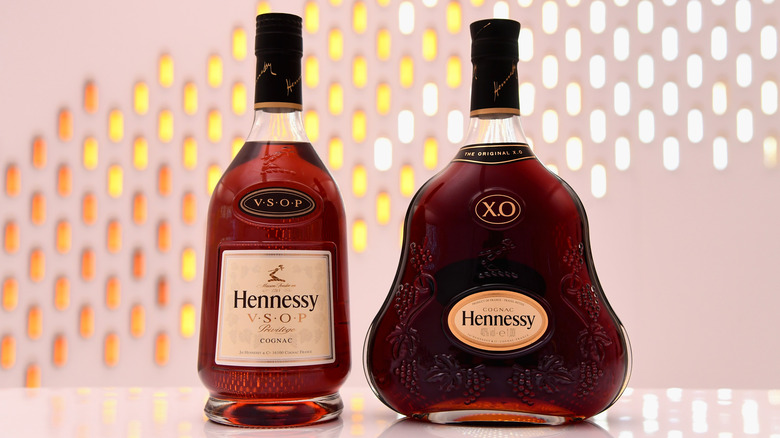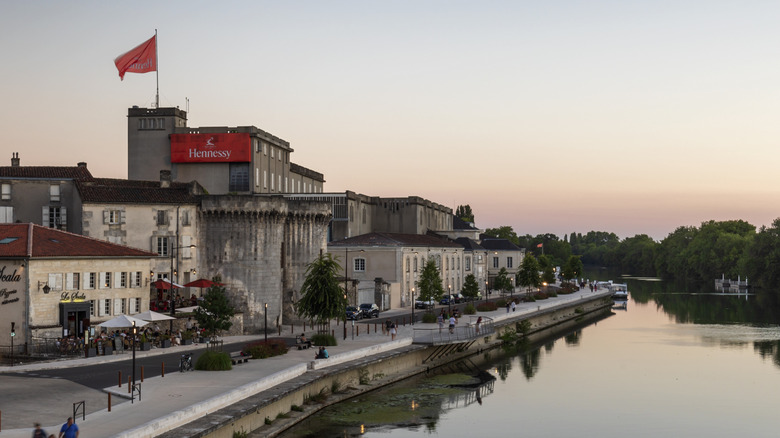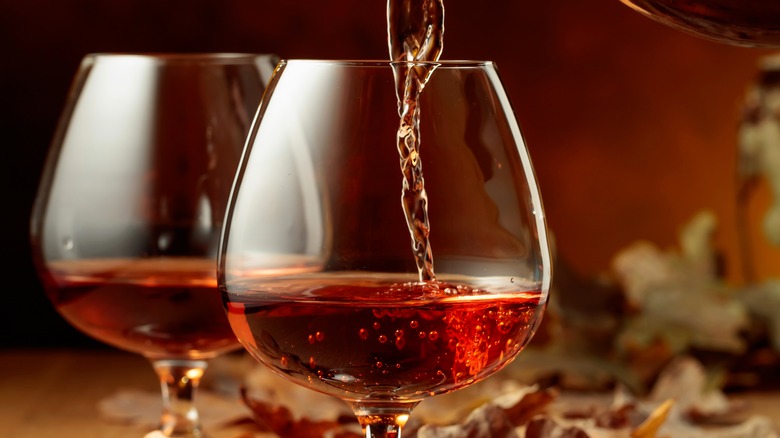What Type Of Alcohol Is Hennessy?
Hennessy was making Cognac long before it became linked with hip-hop culture and celebrated in songs by icons like Drake, Snoop Dogg, and Tupac Shakur. The brand's founding dates all the way back to 1765, and today, it's considered one of the "big four" Cognac producers, along with Courvoisier, Martell, and Rémy Martin. Hennessy beats all of its rivals in terms of sales, selling more than three times as many cases as runner-up Martell in 2022. While this rich liquor is often confused for whiskey due to their similar colors and aromas, Hennessy is, in fact, a special type of brandy.
Cognac stands out in the world of brandy because it must be made within a specific area, using certain wine grapes and traditional distillation methods, in order to carry the name. This makes it somewhat similar to Armagnac, though these special brandies have plenty of differences. The Cognac region is in southwest France, just north of the famed wine region of Bordeaux. Some 75,000 hectares (more than 185,000 acres) of vineyards thrive there, divided into six different crus of varying quality, though all produce wine grapes that are fermented and distilled to make Cognac.
Hennessy V.S. (meaning Very Special) is the highest-selling Cognac around the world, though it's really an essential French spirit through and through. In addition, Hennessy also produces V.S.O.P. (Very Special Old Pale) and X.O (Extra Old) Cognacs, as well as a variety of limited edition bottlings.
How Hennessy Cognac is made
Ugni Blanc is the premier wine grape used to make Cognac, accounting for about 98% of the region's annual harvest. A few other grape varieties are legally permitted to be included in this style of liquor, but Hennessy uses only Ugni Blanc for its products. This varietal is noted for its high acidity and low alcohol content.
Out of the six categories of Cognac grapes – Bois Ordinaires, Bons Bois, Fins Bois, Borderies, Petite Champagne, and Grande Champagne — Hennessy distills its brandy from only four of them, including the latter two classes, which are considered to be the very best. To make Cognac, the grapes are fermented into wine and then double distilled using Charentais copper pot stills. Typically, it takes about nine liters of wine to make a single liter of brandy. These distillations are undertaken seasonally and follow the annual wine harvest, beginning in October.
The initial distillation produces a cloudy, low-alcohol spirit called brouillis, with the second go-round turning brouillis into clear-colored eau-de-vie (French for "water of life"). It's this liquid that is finally aged in barrels to make Cognac. Hennessy's products are aged in French oak barrels, with a duration of two years for V.S., four years for V.S.O.P, and six years for X.O., and so on. The casks are stored in chais (climate-controlled warehouses) in Hennessy's maison (its production facility), located on the banks of the Charente River in Cognac.
Hennessy's history in the U.S. and how to drink it
Hennessy's founder Richard Hennessy was originally from Ireland, but fought in the French army before retiring to make Cognac. Success was not long in coming. Hennessy was shipping its products to the U.S. by 1794, and to another major market, Russia, by 1818. The U.S. remains one of the largest consumers of Hennessy, although China has also emerged as a leading export destination. Hennessy's popularity with Black consumers in the U.S. dates back to the 1950s, with the hip-hop connection firmly established by the 1990s. Hennessy honored this relationship in 2023, commemorating the 50th anniversary of hip-hop with a limited-edition bottle in collaboration with legendary rapper Nas.
Traditionally, Hennessy products are enjoyed neat in balloon-style snifters, so drinkers can enjoy their bold aromas and flavors of fruit, nuts, vanilla, oak, and spice. You'll definitely pick up on similarities to whiskey, mainly because those grain-based liquors are also aged in wooden barrels. Hennessy Cognacs (particularly younger expressions like V.S. or V.S.O.P.) are commonly included in cocktails, too.
The sidecar, a refreshing classic cocktail featuring Cognac with orange-flavored liqueur and lemon juice, is a popular choice, as is the French 75, a bubbly cocktail that pairs Cognac with Champagne. The French Connection is another nightclub favorite, with Hennessy (or other Cognac) mixed with almond-flavored amaretto. The two ingredients play up each other's nutty and fruity notes.



